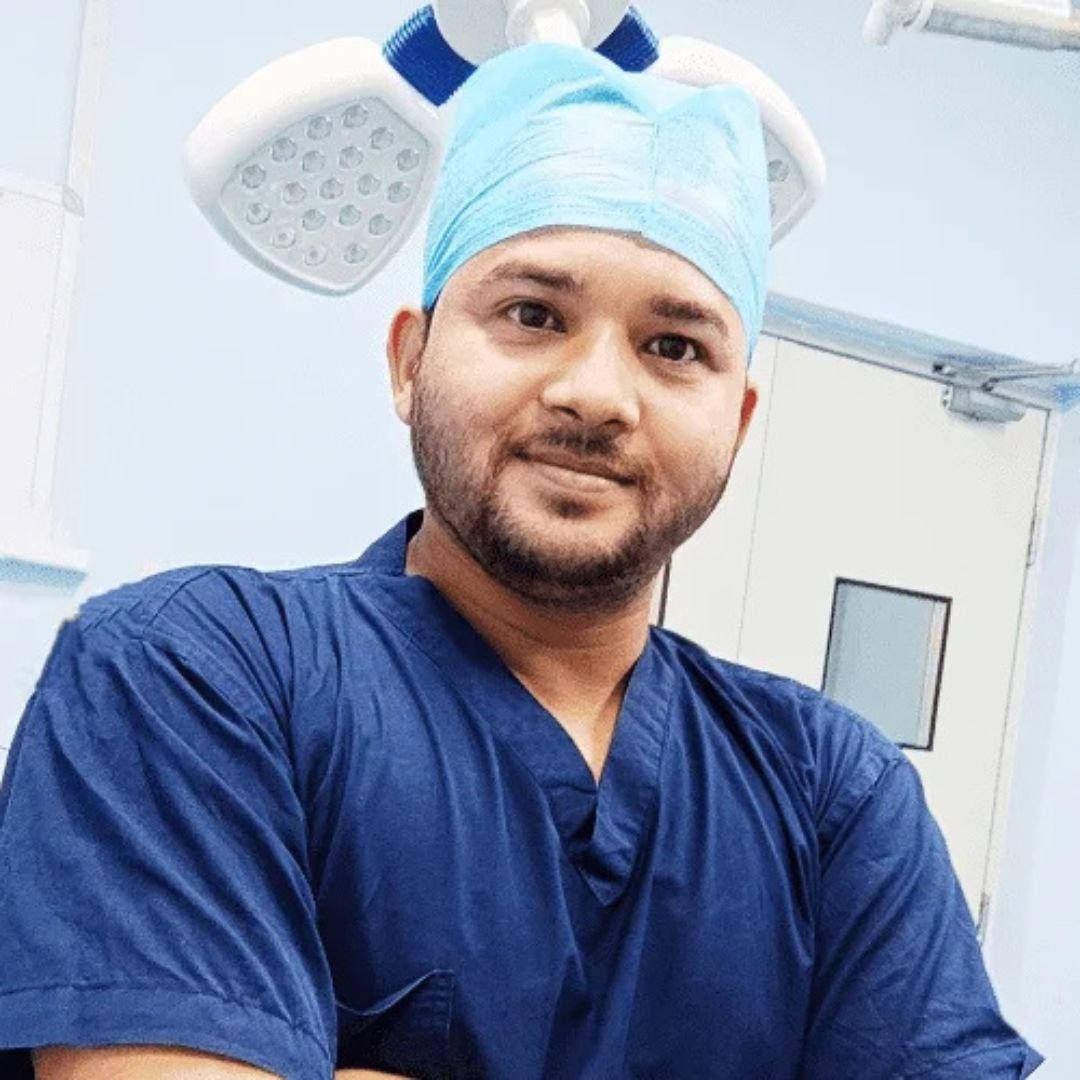Anal Fissure Treatment - Symptoms, Causes, and Effective Solutions
An anal fissure is a small tear or cut in the lining of the anus, which can cause significant pain, discomfort, and bleeding during bowel movements. While it is a common condition, many people hesitate to seek treatment due to embarrassment. However, timely intervention is crucial to prevent complications and ensure a speedy recovery. At Bharatkare, we provide advanced and effective treatments for anal fissures, including laser treatment for anal fissure, home remedies for anal fissure, and surgical options when necessary. If you’re experiencing symptoms, consult our anal fissure specialist today for personalized care.
Book Appointments With Our Expert Doctors Near You
- Get consultation for 50+ diseases across India
- In-person and online consultation with experienced doctors
- Extensive medical assistance throughout your treatment


Dr Ashish Sachdeva
MBBS, MS - General Surgery, General Surgeon, Bariatric Surgeon, Laparoscopic Surgeon
4.9/5
20 Years Experience
Vadodara, India

Dr. Tanmay Jain
General Surgeon, Laparoscopic Surgeon and Proctologist
4.9/5
12 Years Experience
Jaipur, India

Dr. Vikram Vasuniya
MBBS, MS (General Surgery) General Laparoscopic & Laser Surgeon, Laser Proctologist
4.9/5
14 Years Experience
Bhopal, India

Dr. Sujeet Kumar Bharti
MBBS, MS (General Surgery) General Laparoscopic & Laser Surgeon, Laser Proctologist
4.9/5
22 Years Experience
Patna, India
What is an Anal Fissure?
An anal fissure is a small tear or crack in the thin, moist tissue (mucosa) that lines the anus. It often occurs when passing hard or large stools, leading to pain, bleeding, and discomfort. Anal fissures can be acute (short-term) or chronic (lasting more than six weeks). While they can affect anyone, they are more common in young adults and middle-aged individuals.
Key Characteristics of Anal Fissures:
- Pain during bowel movements: Sharp, burning, or tearing pain is the most common symptom.
- Bleeding: Bright red blood may appear on toilet paper or in the stool.
- Itching and irritation: The area around the anus may feel itchy or irritated.
- Spasms: The anal sphincter muscle may spasm, causing additional discomfort.
If left untreated, anal fissures can lead to complications such as infections or chronic pain. Early diagnosis and treatment are essential to prevent these issues.
Disease name
Anal Fissure
Surgery name
Lateral Internal Sphincterotomy
Duration
15 to 20 Minutes
Treated by
General Surgeon
Types of Anal Fissures
Anal fissures are classified into two main types based on their duration and severity:
- Acute Anal Fissures:
- These are short-term and usually heal within a few weeks with proper care.
- Symptoms include mild pain and occasional bleeding.
- Home remedies for anal fissure and lifestyle changes are often effective in treating acute fissures.
- Chronic Anal Fissures:
- These last for more than six weeks and may require medical intervention.
- Symptoms include severe pain, persistent bleeding, and the formation of a skin tag (sentinel pile) at the fissure site.
- Chronic fissures may need antibiotics for anal fissure, laser treatment for anal fissure, or surgical options.
Causes and Risk Factors of Anal Fissures
Understanding the causes and risk factors of anal fissures can help in prevention and effective treatment. Common causes include:
- Constipation: Straining during bowel movements due to hard stools is the leading cause of anal fissures.
- Diarrhea: Frequent loose stools can irritate the anal lining, leading to fissures.
- Childbirth: Women may develop anal fissures due to trauma during delivery.
- Anal intercourse: This can cause tears in the anal tissue.
- Inflammatory Bowel Disease (IBD): Conditions like Crohn’s disease increase the risk of fissures.
- Poor diet: A diet low in fiber can lead to constipation and fissures.
- Sedentary lifestyle: Lack of physical activity can contribute to digestive issues.
Symptoms of Anal Fissures
The symptoms of anal fissures can vary depending on their severity. Common signs include:
- Pain during and after bowel movements: This is often described as a sharp, burning sensation.
- Bright red blood: Visible on toilet paper or in the toilet bowl.
- Itching and irritation: Around the anal area.
- Muscle spasms: The anal sphincter may tighten, causing additional pain.
- Skin tags: In chronic cases, a small lump of skin (sentinel pile) may form near the fissure.
If you experience these symptoms, consult an anal fissure doctor near me for a proper diagnosis and treatment plan.
Diagnosis of Anal Fissures
Diagnosing an anal fissure typically involves a physical examination and a review of your medical history. Here’s what to expect during the diagnostic process:
- Physical Examination:
- The doctor will visually inspect the anal area to check for tears, skin tags, or other abnormalities.
- A gentle digital rectal exam may be performed to assess the severity of the fissure.
- Anoscopy:
- A small, lighted tube (anoscope) is inserted into the anus to examine the anal canal and rectum.
- This helps in identifying the exact location and size of the fissure.
- Sigmoidoscopy or Colonoscopy:
- These procedures may be recommended if the doctor suspects underlying conditions like IBD or colorectal cancer.
- Imaging Tests:
- In rare cases, imaging tests like MRI or ultrasound may be used to rule out other conditions.
Difference Between Anal Fissure and Hemorrhoids
Many people confuse anal fissures with hemorrhoids due to similar symptoms like pain and bleeding. However, these are distinct conditions:
Feature | Anal Fissure | Hemorrhoids |
Definition | A tear in the lining of the anus. | Swollen veins in the rectum or anus. |
Pain | Sharp, burning pain during bowel movements. | Dull ache or discomfort, especially when sitting. |
Bleeding | Bright red blood on toilet paper. | Bright red blood, often more profuse. |
Itching | Mild to moderate itching. | Intense itching and irritation. |
Treatment | Home remedies for anal fissure, laser treatment for anal fissure, or surgery. | Lifestyle changes, medications, or surgery. |
If you’re unsure whether you have an anal fissure or hemorrhoids, consult an anal fissure specialist for an accurate diagnosis.
Difference Between Anal Fissure and Fistula
Another condition often confused with anal fissures is an anal fistula. Here’s how they differ:
Feature | Anal Fissure | Anal Fistula |
Definition | A tear in the anal lining. | An abnormal tunnel between the anus and skin. |
Cause | Trauma from hard stools or diarrhea. | Often caused by an abscess or infection. |
Symptoms | Pain, bleeding, and itching. | Pain, swelling, discharge, and fever. |
Treatment | Home remedies for anal fissure, laser treatment for anal fissure, or surgery. |
|
Treatment Options for Anal Fissures
The treatment for anal fissures depends on the severity of the condition. While acute fissures often heal with conservative measures, chronic fissures may require medical or surgical intervention. Below, we explore the various treatment options available:
1. Home Remedies for Anal Fissure
For mild cases of anal fissures, home remedies for anal fissure can be highly effective. These remedies focus on reducing pain, promoting healing, and preventing recurrence. Here are some proven home treatments:
a. Sitz Baths
- A sitz bath involves sitting in warm water for 10–15 minutes, 2–3 times a day.
- This helps relax the anal sphincter, improve blood flow, and reduce pain and inflammation.
- Adding Epsom salt to the water can enhance its healing properties.
b. Coconut Oil for Anal Fissures
- Coconut oil has natural anti-inflammatory and moisturizing properties.
- Applying a small amount of coconut oil to the affected area can soothe irritation and promote healing.
c. Petroleum Jelly for Anal Fissure
- Petroleum jelly acts as a protective barrier, preventing further irritation during bowel movements.
- Apply a thin layer of petroleum jelly to the anal area before and after using the toilet.
d. High-Fiber Diet (Anal Fissure Diet)
- A diet rich in fiber softens stools, making them easier to pass and reducing strain on the anal area.
- Include foods like fruits, vegetables, whole grains, and legumes in your anal fissure diet.
- Fiber supplements like psyllium husk can also be beneficial.
e. Hydration
- Drinking plenty of water helps prevent constipation, a major cause of anal fissures.
- Aim for at least 8–10 glasses of water daily.
f. Exercise for Anal Fissure
- Regular physical activity improves digestion and prevents constipation.
- Gentle exercises like walking, yoga, and stretching can be particularly helpful.
2. Medications for Anal Fissure
When home remedies for anal fissure are not sufficient, medications may be prescribed to relieve symptoms and promote healing. Common medications include:
a. Topical Creams and Ointments
- Nitroglycerin for Anal Fissure: Nitroglycerin ointment helps relax the anal sphincter and improve blood flow to the area, promoting healing.
- Gel for Anal Fissure: Over-the-counter gels containing lidocaine or hydrocortisone can numb the area and reduce pain and inflammation.
b. Antibiotics for Anal Fissure
- If the fissure is infected, antibiotics for anal fissure may be prescribed to prevent complications.
- Common antibiotics include amoxicillin-clavulanate and metronidazole.
c. Stool Softeners and Laxatives
- These medications help prevent constipation and reduce strain during bowel movements.
- Examples include docusate sodium and polyethylene glycol.
d. Calcium Channel Blockers
- Topical calcium channel blockers like diltiazem can relax the anal sphincter and improve blood flow to the fissure.
3. Laser Treatment for Anal Fissure
For chronic or severe anal fissures that do not respond to conservative treatments, laser treatment for anal fissure is a highly effective option. This minimally invasive procedure uses laser energy to precisely target and heal the fissure.
Benefits of Laser Treatment for Anal Fissure:
- Minimal Pain: Laser treatment is less painful compared to traditional surgery.
- Quick Recovery: Patients can resume normal activities within a few days.
- Reduced Risk of Infection: The laser sterilizes the area, lowering the risk of infection.
- High Success Rate: Laser treatment has a high success rate in healing chronic fissures.
Procedure:
- The patient is given local or general anesthesia.
- A laser beam is used to remove damaged tissue and promote healing.
- The procedure takes about 30 minutes and is performed on an outpatient basis.
Recovery:
- Patients may experience mild discomfort for a few days.
- Follow-up care includes sitz baths, a high-fiber diet, and avoiding strenuous activities.
4. Surgical Options for Anal Fissure
In cases where other treatments fail, surgery may be recommended. Common surgical procedures include:
a. Lateral Internal Sphincterotomy (LIS)
- This procedure involves making a small cut in the anal sphincter to reduce muscle spasms and promote healing.
- It is highly effective but carries a small risk of incontinence.
b. Fissurectomy
- A fissurectomy involves removing the fissure and any scar tissue.
- This procedure is often combined with LIS for better results.
c. Anal Fissure Operation
- In rare cases, a more extensive surgery may be required to repair the fissure.
- Recovery from an anal fissure operation may take several weeks.
5. Lifestyle Changes to Prevent Anal Fissures
Preventing anal fissures involves adopting healthy habits that promote smooth bowel movements and reduce strain on the anal area. Here are some tips:
a. Follow an Anal Fissure Diet
- Include high-fiber foods like fruits, vegetables, and whole grains.
- Avoid foods that can cause constipation, such as processed foods, dairy, and red meat.
b. Stay Hydrated
- Drink plenty of water throughout the day to keep stools soft.
c. Practice Good Toilet Habits
- Avoid straining during bowel movements.
- Do not delay going to the toilet when you feel the urge.
d. Exercise Regularly
- Engage in physical activities like walking, yoga, or swimming to improve digestion.
e. Maintain Proper Hygiene
- Keep the anal area clean and dry to prevent irritation and infection.
6. Yoga for Anal Fissure
Yoga can be an excellent addition to your treatment plan. Certain yoga poses improve digestion, reduce stress, and promote healing. Here are some recommended poses:
a. Pavanamuktasana (Wind-Relieving Pose)
- This pose helps relieve gas and improve digestion.
b. Malasana (Garland Pose)
- Malasana stretches the pelvic area and promotes bowel movements.
c. Balasana (Child’s Pose)
- This relaxing pose reduces stress and improves blood flow to the anal area.
d. Vajrasana (Thunderbolt Pose)
- Practicing Vajrasana after meals aids digestion and prevents constipation.
Recovery After Anal Fissure Treatment
Recovery from anal fissure treatment depends on the type of treatment received. While home remedies for anal fissure and non-surgical treatments typically involve minimal downtime, surgical procedures like laser treatment for anal fissure or an anal fissure operation may require a longer recovery period. Below, we provide a comprehensive guide to help you navigate the recovery process effectively.
1. Recovery After Non-Surgical Treatments
a. Pain Management
- Mild pain or discomfort may persist for a few days.
- Over-the-counter pain relievers like acetaminophen or ibuprofen can help manage pain.
- Topical creams or ointments, such as nitroglycerin for anal fissure or gel for anal fissure, can provide relief.
b. Bowel Movements
- Stools may be softer and easier to pass due to dietary changes and stool softeners.
- Avoid straining during bowel movements to prevent re-injury.
c. Hygiene
- Keep the anal area clean and dry to prevent infection.
- Use a sitz bath 2–3 times a day to soothe the area and promote healing.
d. Activity Level
- Most patients can resume normal activities within a few days.
- Avoid heavy lifting or strenuous exercise until the fissure has fully healed.
2. Recovery After Laser Treatment for Anal Fissure
Laser treatment for anal fissure is a minimally invasive procedure with a relatively quick recovery time. Here’s what to expect during the recovery process:
a. Immediate Post-Procedure Care
- You may experience mild discomfort or a burning sensation in the treated area.
- Apply ice packs or cold compresses to reduce swelling and pain.
b. Pain Management
- Over-the-counter pain relievers are usually sufficient to manage post-procedure pain.
- Your doctor may prescribe a mild painkiller if needed.
c. Bowel Movements
- Stools may be softer and less painful to pass.
- Continue following an anal fissure diet rich in fiber and stay hydrated.
d. Hygiene
- Take sitz baths 2–3 times a day to keep the area clean and promote healing.
- Avoid using harsh soaps or wipes that may irritate the area.
e. Activity Level
- Most patients can return to work and light activities within 1–2 days.
- Avoid strenuous exercise or heavy lifting for at least 1–2 weeks.
f. Follow-Up Appointments
- Attend all scheduled follow-up appointments with your anal fissure specialist to monitor healing progress.
3. Recovery After Anal Fissure Surgery
For patients undergoing an anal fissure operation, such as a lateral internal sphincterotomy (LIS) or fissurectomy, the recovery process may take longer. Here’s what to expect:
a. Immediate Post-Operative Care
- You may experience pain, swelling, and mild bleeding in the surgical area.
- Your doctor will provide instructions on wound care and pain management.
b. Pain Management
- Prescription painkillers may be necessary for the first few days.
- Sitz baths and cold compresses can help reduce pain and swelling.
c. Bowel Movements
- Stools may be softer and less painful to pass.
- Use stool softeners or laxatives as prescribed to prevent constipation.
d. Hygiene
- Keep the surgical area clean and dry to prevent infection.
- Take sitz baths 2–3 times a day to promote healing.
e. Activity Level
- Rest and avoid strenuous activities for at least 2–3 weeks.
- Gradually resume light activities as tolerated.
f. Follow-Up Appointments
- Regular follow-up appointments are essential to monitor healing and address any complications.
4. Tips for a Smooth Recovery
Whether you’ve undergone non-surgical treatment, laser treatment for anal fissure, or an anal fissure operation, these tips can help ensure a smooth recovery:
a. Follow an Anal Fissure Diet
- Continue eating a high-fiber diet to prevent constipation.
- Include foods like fruits, vegetables, whole grains, and legumes.
- Avoid foods that can cause constipation, such as processed foods, dairy, and red meat.
b. Stay Hydrated
- Drink plenty of water throughout the day to keep stools soft.
c. Practice Good Toilet Habits
- Avoid straining during bowel movements.
- Do not delay going to the toilet when you feel the urge.
d. Maintain Proper Hygiene
- Keep the anal area clean and dry to prevent irritation and infection.
- Use gentle, unscented wipes or a bidet for cleaning.
e. Avoid Heavy Lifting
- Refrain from lifting heavy objects or engaging in strenuous activities until fully healed.
f. Manage Stress
- Stress can affect digestion and bowel movements. Practice relaxation techniques like deep breathing, meditation, or yoga.
5. Preventing Recurrence of Anal Fissures
Preventing anal fissures from recurring is crucial for long-term relief. Here are some preventive measures:
a. Follow a High-Fiber Diet
- A diet rich in fiber helps maintain regular bowel movements and prevents constipation.
- Consider taking anal fissure dietary supplements like psyllium husk if needed.
b. Stay Active
- Regular exercise improves digestion and prevents constipation.
- Incorporate activities like walking, yoga, or swimming into your routine.
c. Practice Good Toilet Habits
- Avoid sitting on the toilet for extended periods.
- Use a footstool to elevate your feet while sitting on the toilet, which can help align the rectum for easier bowel movements.
d. Manage Chronic Conditions
- If you have conditions like Crohn’s disease or irritable bowel syndrome (IBS), work with your doctor to manage them effectively.
e. Avoid Irritants
- Avoid using harsh soaps, scented wipes, or tight clothing that can irritate the anal area.
When to Consult a Doctor
While most anal fissures heal with proper care, consult your anal fissure doctor if you experience any of the following:
- Severe pain or bleeding that does not improve with treatment.
- Signs of infection, such as fever, swelling, or pus.
- Recurrence of fissures despite following preventive measures.
Why Choose Bharatkare?
- Expert Specialists: Consult with the best anal fissure specialists near you.
- Advanced Treatments: Benefit from cutting-edge procedures like laser treatment for anal fissure.
- Personalized Care: Receive tailored treatment plans that suit your unique needs.
- Comprehensive Support: From home remedies for anal fissure to post-operative care, we’re with you every step of the way.
Conclusion
Anal fissures, though common, can cause significant discomfort and disrupt daily life if left untreated. The good news is that effective treatments are available, ranging from home remedies for anal fissure to advanced procedures like laser treatment for anal fissure. Whether you’re dealing with an acute or chronic fissure, timely intervention is key to preventing complications and ensuring a speedy recovery.
At Bharatkare, we understand the sensitivity of this condition and are committed to providing compassionate, personalized care. Our team of experienced anal fissure specialists uses state-of-the-art technology and evidence-based treatments to help you regain your quality of life. From dietary advice like an anal fissure diet to minimally invasive procedures, we offer comprehensive solutions tailored to your needs.
Don’t let embarrassment or fear prevent you from seeking help. Anal fissures are a treatable condition, and with the right care, you can achieve lasting relief. Take the first step toward healing today.
FAQ
You Can Find All Answers Here
Yes, acute anal fissures can often heal on their own with proper care, such as:
- Following an anal fissure diet rich in fiber.
- Staying hydrated.
- Using home remedies for anal fissure like sitz baths and coconut oil for anal fissures.
- Avoiding straining during bowel movements.
However, chronic fissures may require medical intervention, such as antibiotics for anal fissure, laser treatment for anal fissure, or surgery.
To prevent worsening of symptoms, avoid the following foods:
- Spicy foods: Can irritate the digestive system.
- Processed foods: Low in fiber and high in unhealthy fats.
- Dairy products: May cause constipation in some people.
- Red meat: Difficult to digest and low in fiber.
- Alcohol and caffeine: Can lead to dehydration and constipation.
Instead, focus on an anal fissure diet that includes high-fiber foods like fruits, vegetables, and whole grains.
Yes, laser treatment for anal fissure is a safe and effective option for chronic fissures. Benefits include:
- Minimal pain and bleeding.
- Quick recovery time.
- Reduced risk of infection.
- High success rates.
Consult an anal fissure specialist to determine if laser treatment is right for you.
Recovery time after an anal fissure operation varies depending on the type of surgery:
- Laser treatment for anal fissure: Most patients recover within 1–2 weeks.
- Lateral internal sphincterotomy (LIS): Recovery typically takes 2–4 weeks.
- Fissurectomy: Recovery may take 4–6 weeks.
Follow your doctor’s post-operative care instructions, including sitz baths, a high-fiber diet, and avoiding strenuous activities.
Yes, petroleum jelly for anal fissure can help soothe the area and reduce irritation. Apply a thin layer to the anal area before and after bowel movements to protect the fissure and promote healing.
Gentle exercises can improve digestion and prevent constipation, which is beneficial for anal fissures. Recommended exercises include:
- Walking: Improves bowel movements.
- Yoga for anal fissure: Poses like Pavanamuktasana (Wind-Relieving Pose) and Malasana (Garland Pose) can help.
- Kegel exercises: Strengthen pelvic floor muscles.
Avoid heavy lifting or strenuous activities that may strain the anal area.
To find an anal fissure doctor near me, you can:
- Search online for anal fissure specialists in your area.
- Ask for recommendations from your primary care physician.
- Check reviews and ratings of local proctologists or colorectal surgeons.
The anal fissure surgery cost varies depending on the type of procedure, location, and healthcare provider. For accurate pricing, consult your anal fissure specialist or contact your insurance provider.
Yes, nitroglycerin for anal fissure is a common treatment. It works by relaxing the anal sphincter and improving blood flow to the area, promoting healing. Apply the ointment as prescribed by your doctor.
Yes, anal fissure dietary supplements like psyllium husk or methylcellulose can help soften stools and prevent constipation. Always consult your doctor before starting any supplements.
Quick Links
Popular Surgeries
Find Us
© Copyright BharatKare 2025. All Right Reserved.



